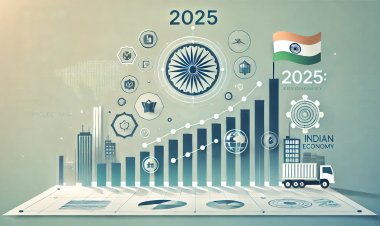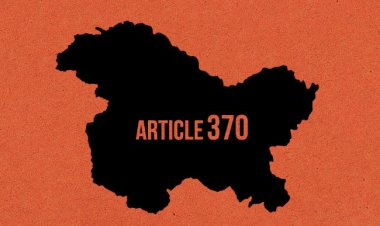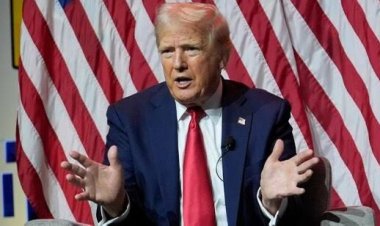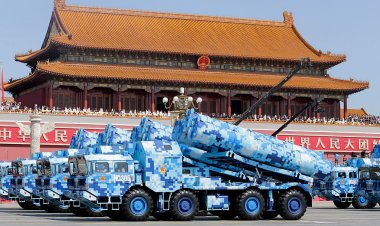China's Sinking Economy
This paper discusses China's economic crisis and how the $18 trillion worth Chinese economy is encountering diminishing growth rates with each successive financial year.
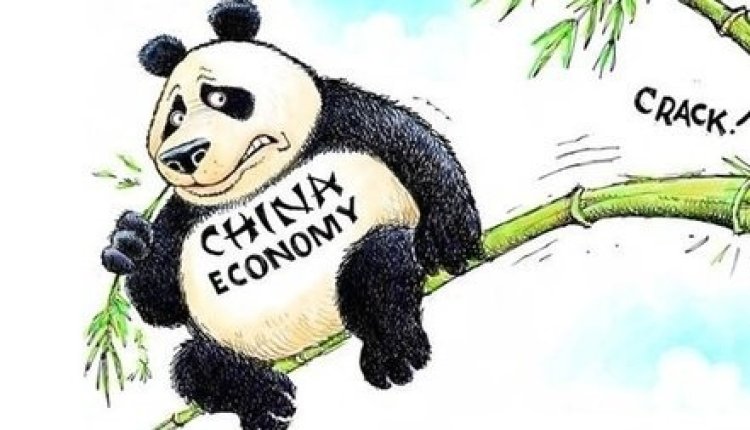
Analysis
By Mehak Johari
As the world emerges from the grip of the deadly Covid-19 pandemic, countries are gradually recovering on both medical and economic fronts. However, this recovery has not been uniform. What was supposed to be a year of growth and stability has turned out to be another year of challenges for the Chinese government and its citizens. The $18 trillion worth Chinese economy is encountering diminishing growth rates with each successive financial year. This is reflected by its exports which have experienced the sharpest decline in three years, faring a worse-than-expected export rate of 12.4% year-on-year. As the global demand for goods and services wanes, it exacerbates the strain on China’s economy. This has led economists and analysts all over the world to dig deeper into the factors at the root cause of this situation, its consequences, and the way forward for the Dragon.
The Chinese economy grew at a growth rate of 4.5% during the first quarter of 2023 and while it is still on its track to achieve its modest growth rate target of 5% for the FY2023, any more slowdown in the growth rate could negatively impact its employment levels, which are already at an all-time low, and fuel deflationary risks. While a growth rate of 5% would be a cause for celebration in many parts of the world, it is important to understand why it is a cause of concern for the Chinese state. For decades, China has boasted economic growth that has surpassed all its competitors, often achieving growth rate in the double-digit range. China has always taken pride in the growth it has been able to achieve in the last two decades; 10.1% in 2004, 11.4% in 2005, 12.7% in 2006 and even reaching the exceptional 15% during Q2 of 2017. Thus, even though the Chinese economy is still growing, it is this relative slowdown in its current growth rate that has become a cause for concern for not just Chinese policy makers and citizens but also for
economists all over the world. This paper attempts to analyze the various causes of China’s sluggish economic returns, its consequences for its global ambitions and for the world at large, and finally the various fiscal and structural reforms undertaken by the Chinese government to overcome these challenges.
Root Causes of the Sluggish Economy
As the borders reopened and economies restarted in the post-Covid world, countries began to resume their financial business as before. China, like all other economies, expected the consumers to come back to the markets and spend. It was expected that once the borders opened for trade again, there would be a flood of consumer spending because of ‘revenge spending’[1]. While China experienced this upsurge in consumption for the first few months, it did not last for long, and the Chinese economy started losing its initial momentum. Due to the high economic uncertainties brought by the Pandemic, cautious households and private businesses started building up their savings and redirected their spending to paying off their debts rather than making new purchases or investments. In addition to the fading of the reopening effect and weak consumption momentum, China continued to face a sluggish real estate market and decelerating external demand amid an overall economic slowdown. On top of this, the Chinese economy entered a deflation cycle with zero growth of CPI and negative PPI for the past several months[4]. Other than these challenges, the local governments are currently in substantial debt, the country is facing a shrinkage in its labor force due to its aging population, and there is an urgent need for industrial upgradation and transformation[5].
Real Estate Crisis
China’s massive property industry has been the main driver of its economy for decades, accounting for about 30% of the country’s GDP. However, China’s booming property market, that once meant that owning a property in China was a short shot way of gaining wealth, is now under severe crisis. China’s National Bureau of Statistics estimated in a report that the property investment in China fell as much as 10% year-on-year in 2022, the first decline since 1999.
Numerous cash-strapped and financially struggling builders in China have halted the construction of numerous projects due to the country’s real estate slump. As an estimate by the Shanghai E-House Real Estate Research Instituted showed, this has become more than a cause for concern. About 3.85% of China’s housing market, equivalent to 231 million square meters, comprised of these stalled projects. One of the primary reasons for this is the ‘Pre-sale market’ system followed in China. Under this system, developers get the opportunity to sell houses to buyers before they are fully built. While this system enabled developers to cater to the growing demand for houses created by the rapid urbanization of Chinese cities by using that money to invest in future construction projects, there were certain risks attached to this system for the buyers. First, the homeowners were expected to pay the full amount to the developer before they ever got possession of the house. Equally concerning, these transactions were not regulated by any third party like law firms. Correspondingly, should there be a cash crunch, the money that was supposed to be paid for the completion of houses had to be redirected to certain other mandatory expenses like the payment of wages to construction workers, leaving many houses and housing complexes incomplete.
China’s real estate bubble has been another contributing factor to the country’s economic crisis. As discussed above, since the 1990s, China’s real estate market has been undergoing a boom due to the country’s rapid urbanization, which meant that the property prices were rapidly increasing too. China witnessed a period of overbuilding to cater to the demand created by the people migrating from rural to urban areas during the 1990s. There was a rise of 37% in its urban population between 1990 and 2021 which increased the demand for the construction of more flats. Chinese people started buying houses not to live in them but as investments, to sell these houses later for a profit under the expectations that the prices would keep rising. This created a real estate bubble forcing the government to initiate a massive crackdown on the real estate sector to address its various issues. It aimed at reducing the developers’ leverage by implementing stricter regulations on them and curbing speculative practices; lowering the risk in the financial sector by putting limits on the debt levels of the real estate developers; making houses more affordable for the people; and promoting sustainable development of the sector. However, despite the government’s efforts, this bubble was bound to burst and when that happened, property prices plunged abruptly and significantly. This created a huge crisis for all those who spent all their fortunes and savings to buy real estate properties at very high rates, expecting higher returns in future as they now owed more money than what their properties were actually worth. Simultaneously, the Covid-19 Pandemic sent both housing sales and their prices on a downward slope in the market. Beijing was compelled to enforce the Three Red Lines to put a cap on 3 debt ratios for the developers. These included a liability-to-asset ratio of less than 70%, a net debt-to-equity of less than 100%, and a cash to short-term ratio of 1. All those developers that failed to fulfill these criteria lost their funding which consequently increased their financial burden. This financial burden forced them to halt their ongoing projects, creating resentment amongst the Chinese homeowners and ultimately leading to their refusal to pay their mortgages on the unfinished houses. Other effects of the real estate bubble burst included a reduction in the sale of state-owned land by the local governments who relied on these land sales for their revenue, affecting the funding of other infrastructural projects in their respective localities and causing massive debt accumulation.
Experts have claimed that the real estate market in China became too big too soon for the economy, to be able to sustain it in the long term. Others claim that the Three Red Line Policy wasn’t necessarily wrong, however they believe that it was merely introduced at the wrong time. Economists have claimed that the real issue is the demand-supply imbalance created by the rapidly declining Chinese population. This significant decline in population, combined with the stagnant disposable income of its citizens and the high rate of unemployment faced by the youth in the country, have together contributed to the issue. The government has signaled that Beijing may ease the ‘Three Red Lines’ Policy, however, the mere reliefs in policy are not going to solve the crisis. There is an urgent need to readjust the whole market by introducing certain short-term and long-term structural reforms in the country that address the various root causes of the problem simultaneously.
The Large Debt of Local Governments
Some 10-15 years back, when China was still faring growth rates in double digits, whenever the government feared an economic slowdown, it would borrow money at the local level and invest in building more infrastructure which increased the demand for cement and steel and kickstarted economic activity once again. However, currently the Chinese local governments are under immense debt which has forced them to look for alternative means of stimulating the economy. As per a Goldman Sachs report, the Chinese local government is under $23 trillion of debt. JPMorgan Chase calculate China’s overall debt to be 282% of the country’s annual economic output. We can understand the gravity of this situation by the fact that China’s local government’s debt equates to roughly 7 times India’s GDP. What is striking about China’s debt is how fast it has accumulated relative to the size of its economy. As the economy slows down with each successive financial year, a growing number of local governments and their financing vehicles have failed on their repayment of these debts.
To fully understand this problem, it is imperative to first understand China’s local government structure. Its local government plays a huge role in China economic planning, especially since 2015 when the government amended the Budget Law which allowed local governments to raise funds from the open market by selling bonds, giving them more power and flexibility to finance projects. The Chinese local government’s significant debt can be attributed to a combination of factors like an overemphasis on investment-led growth, a heavy reliance on land sales for revenue, setting up of local government financing vehicles (LGFVs) for off-budget financing methods, the Covid-19 pandemic, and a focus on short-term growth over long-term sustainable growth. The Chinese economy, since Deng Xiaoping, has focused more on an investment-led growth strategy that gives primacy to investments in infrastructure, real estate, and industrial growth. However, the government often has often had to borrow money to fund these large-scale infrastructural and capital projects, leading to a high accumulation of debt. With the real estate bubble burst, land sales have considerably declined, thereby plummeting government revenue. This situation is aggravated by the homeowners who continually refuse to pay their mortgages on incomplete and uninhabitable houses. Complicating things further, insufficient, and fast diminishing capital has made it difficult for the developers to bid for land. Resultingly, both the local government and developers stand before a daunting financial crisis. Some local governments have set up Local Government Financing Vehicles (LGFVs) to borrow money on behalf of municipalities without having to reflect this debt in the official balance sheets of the localities. This has led to a phenomenon of ‘hidden borrowing’ which has in turn led to a hidden debt accumulation. The government’s financing vehicles continue to take heavy loans to finance projects but since it can no longer raise funds from the sale of land, their debt has risen monumentally. Finally, the global lockdowns, travel bans, and substantial disruptions in supply chains caused by the Covid-19 Pandemic have had a considerable impact on government revenue. To implement diverse social welfare initiatives to aid citizens during the Pandemic, such as increased investments in healthcare and social aid, the Chinese government found it essential to meet these additional, unplanned expense through borrowing. Moreover, the provision of loan deferrals and extensions to aid pandemic-affected businesses further contributed to the country’s financial strain.
A large part of this debt is also owed by large real estate developers like Evergrande that hold about 1,300 real estate projects spanning over 280 Chinese cities. It currently owes an enormous debt of $300 billion. Given the turmoil, Evergrande has had to file for bankruptcy which becomes a problem for various other businesses like those construction and design firms that would incur heavy losses if Evergrande collapses. Another major impact of Evergrande’s collapse would be on the banks and other lenders in the country who would become more cautious about extending credit due to the heightened risk perceptions and uncertain economic situation. This can lead to a ‘credit crunch’ wherein companies would struggle to borrow money from banks and other lenders at affordable rates. Countries facing a credit crunch find it hard to keep up the functioning of their businesses, in turn adversely affecting foreign investments in the country.
Potential Solutions
While China’s investment-led growth has been beneficial for the country up until now, it needs to understand that the long-term economic costs of this strategy far outweigh its short-term benefits. The economic crisis has shaken the confidence of the Chinese people in their state. The economic slowdown has made people concerned about the prospects and opportunities in the country, especially among the younger generations that are already grappling with the effects of a high unemployment rate. The country seems to be stuck in the Middle-Income Trap, unable to escape it. It must invest in education, vocational training, and skill development; promote innovation and research; divert its resources from production of low-cost goods and services to more advanced sectors like high-tech manufacturing; create a favorable investment environment and reassure its skeptical investors; and finally, implement sound and efficient fiscal management strategies to develop a comprehensive and long-term economic development strategy to escape the Middle-Income trap.
Officially known as the Political Bureau of the Communist Part of China Central Committee, China conducted its Politburo meeting on 24th July 2023. The main objective of the meeting was to analyze the economic situation of the country and deliberate on long-term and short-term policy changes to overcome its current economic and financial chaos. Some of the proposed changes include promulgating stimulus measures, promising housing market easing measures, promulgating local government debt resolution plans, promoting industrial upgradation, boosting the capital markets development, pledging more counter cyclic efforts to enhance domestic demand, improving market sentiments in the short term and finally, promulgating a series of structural reforms to prevent risks in the long-term. The Chinese government expects the economy to rebound during Q3 and Q4 of 2023 in an upward trajectory, which is expected to materialize their target of 5%. Even though the government has taken certain measures to resolve the economic challenges, these macroeconomic reforms have proven to be ineffective and inadequate due to their focus on enterprises and traditional infrastructural investments rather than proving supports to households.
Conclusion
China’s economic turmoil is not just a matter of concern for its government and its citizens but also for the rest of the world. One of the major consequences of the current economic slowdown would be seen in Xi Jinping’s ambitious Belt and Road Initiative (BRI). China’s economic slump has led to increased scrutiny of China’s overseas investments that include the BRI projects. This has affected the progress of some of these projects in different parts of the world as some of them have either been delayed or put on hold temporarily. Given the interconnectedness of the world that we live in, an economic slump in one part of the world is bound to influence other parts of the world as well. With China’s economy accounting for 1/5th of the global GDP, its slowdown can have serious consequences for the world growth rate. China is an important market for products as well as the energy sector and if its economy continues to slow down and if its citizens continue to save more than they spend, then it is going to affect the economies of other nations that depend on Chinese markets for the sale of their goods and services. This makes it imperative for the government to enhance its citizens’ confidence in the government while at the same time find a solution to the real estate bubble burst and the country’s high level of unemployment.
Various uncertainties currently loom over the economic climate of China and only time will tell if the second largest economy of the world would be able to overcome its current challenges to effectively implement the structural reforms needed to revive the economy, escape the Middle-Income trap to achieve a high-income status and address the concerns of both its citizens and investors to be able to re-strengthen its economy. At present, China is undergoing a transitional phase, shifting away from its old economic growth model as introduced by Deng Xiaoping. However, the search for a new economic framework, capable of incorporating certain suitable features from the existing model, continues.
Disclaimer: This paper is the author's individual scholastic contribution and does not necessarily reflect the organization's viewpoint.




